![]()
![]()
![]()
Use LEFT and RIGHT arrow keys to navigate between flashcards;
Use UP and DOWN arrow keys to flip the card;
H to show hint;
A reads text to speech;
42 Cards in this Set
- Front
- Back
- 3rd side (hint)
|
Characteristics of an LSO Profit Revenue Assets Employees Operations |
Profit : substantial Revenue : substantial in the millions Assets : $200m+ Employees : 200+ Operations : multiple branches, transnational |
|
|
|
Define mission statement |
Overall statement that reflects the organisations reason for being |
|
|
|
Define corporate objective |
Long term, 5+ years, set by senior management, strategic |
|
|
|
Define departmental objective |
Medium term, 1-3 years, set by department managers, tactical |
|
|
|
Define operational objectives |
Short term, under a year, set by team leaders |
|
|
|
Define public sector |
Part of the economy owned by the government |
|
|
|
Define private sector |
Part of the economy owned by private individuals and companies. Can be private or public companies. |
|
|
|
Define gbe |
Government owned by try and operate to make a profit or break even (auspost) |
|
|
|
Define GDP and how it can be a positive and negative contribution |
Gross domestic product is the total monetary value of all goods and services produced in Australia in one year. If LSOs produce many goods and services in Australia this is a positive contribution, a high GDP is good as it means Australia has more money, which means people have more money and the government has more money, which can be used to improve the standard of living. If LSOs move production offshore/outsource overseas this is a negative contribution. |
|
|
|
How can an LSO contribute positively/negatively through employment? |
LSOs employ a large percentage of the workforce. If an LSO employs a large percentage of the workforce, Australia benefits as employees earn an income, meaning they have money to spend on consumer items. This is a positive contribution. Additionally, the government receives more money through GST, and other taxes, meaning that they can spend more on improving the standard of living. If they down size this is a negative contribution. |
|
|
|
Define balance of payments and describe how it can contribute to the economy |
Bofp is the annual record of how much Australia imports and exports with the rest of the world. If we import more than export, our Bofp is low, this is bad. If we export more than import, our Bofp is high, this is good. We want it high as it means money is coming into the country and can help the standard of living. |
|
|
|
How can an LSO doing R&D contribute to the economy? |
It costs a lot to find new ways of doing things, therefore, it isn't suitable for small and medium businesses. If LSOs spend money on R&D, they can find new ways of doing things, which is a positive contribution that other organisations may adopt. If LSOs don't spend money, it has a negative contribution, because no new methods or practices are being produced. |
|
|
|
How can an organisation contribute to the economy by growing infrastructure? |
Infrastructure is the physical resources of an area, for example, power, transport, utility services. LSOs can contribute positively by stimulating growth in an area they move into. LSOs can contribute negatively, if they are providing infrastructure but not maintaining it. |
|
|
|
Features of bureaucratic structure |
Clear division of labour Downward communication Centralised decision making Narrow span of control Very controlled and regulated |
|
|
|
Advantages/disadvantages of bureaucratic structure |
More control over employees Save time through already planned processes Discourage creativity Discourage innovation Front line employees may receive less satisfaction from their jobs Less able to adapt to changing conditions in the market place, legal or industry environment |
|
|
|
Features of division structures |
Fewer levels of staff Decebtrised decision making Use of employees knowledge, skills and experience Greater flexibility, thus, better response to change Reduction in costs More teamwork More multi skilled employees |
|
|
|
Advantages/disadvantages of divisional structures |
Greater flexibility More teamwork Fewer levels of staff Wasting time developing procedures to fit individuals Difficult management controk People may not be good at multiple tasks, but specialise in one |
|
|
|
What is a network structure? |
It outsources some of its functions and the central organisation exerts administrative control. This provides additional flexibility. |
|
|
|
What is a matrix structure? |
A structure that places managers and employees into project teams that cut across functional or department lines and required time to report to a number of managers. |
|
|
|
Define corporate culture |
The shared values and beliefs of an organisation |
|
|
|
What are some indicators of corporate culture? |
Formal or written company policies and objectices: company values are also an important indicator. This indicates "official" corporate culture. Physical environment: the layout, the colour scheme, and uniform or dress code are indicators. Organisational structure and management styles: indicates the relationships between people. Organisational processes: how things are done demonstrates what is valued. Rituals and symbols: what is celebrated? How are people addressed: is there an emphasis on titles and formality or are first names used? The language used Official company documentation: brochures and logos. |
|
|
|
What can differ a corporate culture? |
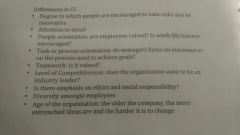
|
|
|
|
Why does an organisation want a good corporate culture? |
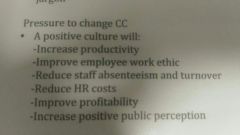
|
|
|
|
Define the management role of planning |
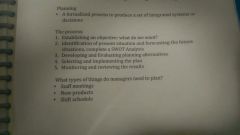
|
|
|
|
What levels of planning exist? |
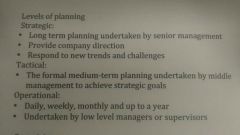
|
|
|
|
Define the management role of organising |
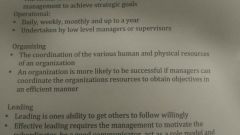
|
|
|
|
Define the management role of leading |

|
|
|
|
What skills does a good leader have? Define them. |
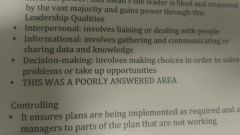
|
|
|
|
Define the management role of controlling |
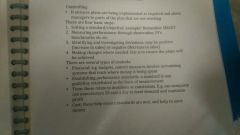
|
|
|
|
Define a policy |
A policy is a written statement detailing procedures, rules and regulations that must be observed in a given situation |
|
|
|
What does a policy do? |
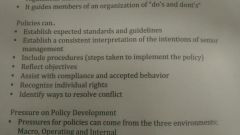
|
|
|
|
Describe each step of the policy development process. |

Policy is displayed and feedback is sought. 6. Policy approval Feedback considered, necessary changes made. Management must approve. 7. Evaluation Was it effective? |
In Ringwood Some People Dine At Eastland... |
|
|
Describe each management style; autocratic, persuasive, consultative, participative, laissez-faire |
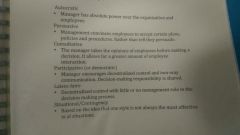
|
|
|
|
Define the management skill of communication |
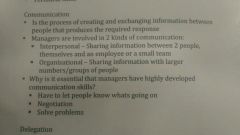
|
|
|
|
Define delegation as a management skill |
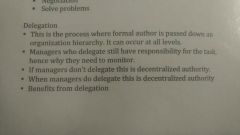
|
|
|
|
Define the management skill of decision-making/problem solving |
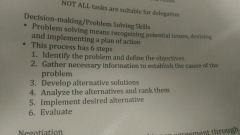
|
|
|
|
Define the management skill of negotiation |
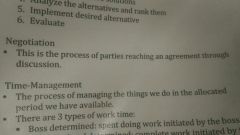
|
|
|
|
Define the management skill of time management |
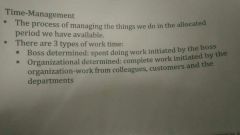
|
|
|
|
Define the management skill of stress management |
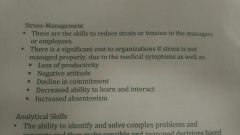
|
|
|
|
Define the management skill of analytical skill |
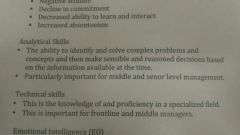
|
|
|
|
Define the management skill of technical skills |
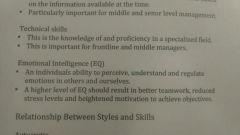
|
|
|
|
Define the management skill of emotional intelligence EQ |

|
|

